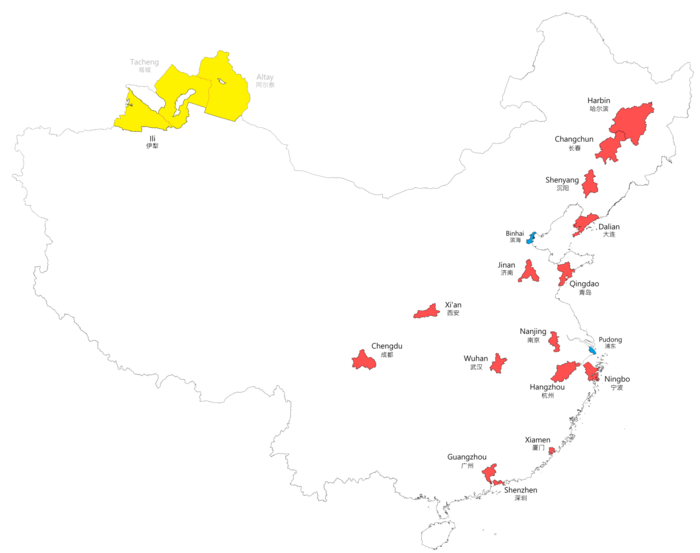A sub-provincial division (Chinese: 副省级行政区; pinyin: Fùshěngjí xíngzhèngqū) in China is a prefecture-level city governed by a province promoted by half-a-level. Thus, it is half-a-level under the provincial level, and half-a-level above the prefecture-level, hence the name "sub-provincial".
The promotion applies to all its subdivisions, administrative institutions, and political parties. For example, the mayor of a sub-provincial division is equal in status to a vice-governor of a province.
A sub-provincial division is still administratively governed by a province, just like prefecture-level divisions. However, five of them are also cities specifically designated in the state plan (Chinese: 计划单列市 / 計劃單列市), which enjoy the provincial level authority over economic issues—governmental finance, customs, economic strategy planning, economic policy, foreign economic affairs, banking, etc.
Sub-provincial divisions, similar to prefectural-level divisions, are administrative units comprising, typically, a main central urban area (the core city) surrounded by rural area, which together are divided into districts, and some surrounding counties or county-level cities (all promoted to sub-prefecture level) governed by the sub-provincial division on behalf of the province, which all have their own urban areas surrounded by their own rural areas.
Map of sub-provincial level entries in China

|
Sub-provincial municipalities
The original 16 municipalities were renamed as the sub-provincial municipalities on 25 February 1994 by the Central Organization Committee out of the prefecture-level municipalities. They are mostly the capitals of the provinces in which they are located.
Currently, there are 15 sub-provincial municipalities after Chongqing was designated direct-control:
Chongqing was formerly a sub-provincial municipality of Sichuan until 14 March 1997, when it was made an independent municipality by splitting it out of Sichuan altogether. The Xinjiang Production and Construction Corps also has the powers of a sub-provincial division.
Chengdu is the largest sub-provincial municipality. It has a population exceeding that of the independent municipality of Tianjin while both Harbin and Chengdu have a bigger land area than Tianjin.
In total, there are five sub-provincial municipalities that are not themselves provincial capitals. These five municipalities have been designated as the "Municipalities with Independent Planning Status" (simplified Chinese: 计划单列市; traditional Chinese: 計劃單列市; pinyin: Jìhuá Dānliè Shì).
Sub-provincial new areas
Additionally, the head of Pudong New Area of Shanghai and Binhai New Area of Tianjin, which is a county-level district, is given sub-provincial powers.
| Division name | Simplified Chinese | Hanyu Pinyin | Municipality | Abbreviation | Region | Population (2010 Census) | Date of designation | Subdivision |
|---|---|---|---|---|---|---|---|---|
| Binhai New Area | 滨海新区 | Bīnhǎi Xīn Qū | Tianjin | 滨海 | North | 2,482,065 | 2009 | 19 Subdistricts & 7 towns (11 special township-level zones) |
| Pudong New Area | 浦东新区 | Pǔdōng Xīn Qū | Shanghai | 浦东 | East | 5,044,430 | 1992 | 13 Subdistricts & 25 towns (6 special township-level zones) |
Sub-provincial autonomous prefecture
Ili Kazakh Autonomous Prefecture has the two prefectures of Altai and Tacheng and 11 directly-controlled county-level administrative divisions under its jurisdiction. It itself is legally only a prefecture-level division, which is a special case in China's administrative divisions. It is not accurate to regard Ili Kazakh Autonomous Region as a sub-provincial administrative division, which has no legal basis. Up until 2001, the Autonomous Prefecture had a 3rd prefecture as well. The directly controlled subdivisions were administered as part of Ili Prefecture (伊犁地区)
| Division name | Simplified Chinese | Hanyu Pinyin | Province | Abbreviation | Region | Population (2010 Census) | Date of designation | Subdivision |
|---|---|---|---|---|---|---|---|---|
| Ili Kazakh Autonomous Prefecture | 伊犁哈萨克自治州 | Yīlí Hāsàkè Zìzhìzhōu | Xinjiang | 伊犁 | Northwest | 4,305,119 | 1979 | (2 prefectures) 5 county cities, 17 counties & 2 autonomous counties |
Sub-provincial Municipal Conference
The National Joint Conference of Sub-provincial City People's Congress Standing Committee Chairpersons (全国副省级城市人大常委会主任联席会议) are attended by the chairpersons and vice-chairpersons of all sub-provincial cities. It was proposed by the Guangzhou Municipal People's Congress in 1985. The conferences:
- Guangzhou (26 February – 4 March 1985)
- Harbin (27–31 August 1985)
- Wuhan (20–24 May 1986)
- Dalian (10–14 August 1987)
- Xi'an (9–13 September 1988)
- Shenyang (13–17 August 1990)
- Chongqing (22–26 November 1991)
- Qingdao (3–7 May 1992)
- Shenzhen (25–28 October 1993)
- Nanjing (1–4 November 1994)
- Changchun (21–24 May 1995)
- Hangzhou (20–24 October 1996)
- Jinan (19–25 October 1997)
- Xiamen (12–16 October 1998)
- Ningbo (17–20 October 1999)
- Chengdu (10–13 October 2000)
- Guangzhou (30 October – 3 November 2001)
- Harbin (23–26 July 2002)
- Wuhan (8–12 October 2003)
- Shenyang (31 August – 6 September 2004)
- Qingdao (6–8 September 2005)
- Shenzhen (20–23 October 2006)
- Dalian (14–16 August 2007)
- Xi'an (13–16 April 2009)
- Nanjing (18–20 October 2010)
- Changchun (22–25 August 2011)
References
- 中央机构编制委员会印发《关于副省级市若干问题的意见》的通知. 中编发[1995]5号. 豆丁网. 1995-02-19. Archived from the original on 2014-05-29. Retrieved 2014-05-28.
- Xue Hongli (薛宏莉) (2008-05-07). 15个副省级城市中 哈尔滨市房价涨幅排列第五名 [Prices rose in 15 sub-provincial cities, Harbin ranked fifth]. 哈尔滨地产 (in Simplified Chinese). Sohu. Retrieved 2008-06-11.
- ^ References and details on data provided in the table can be found within the individual municipality articles.